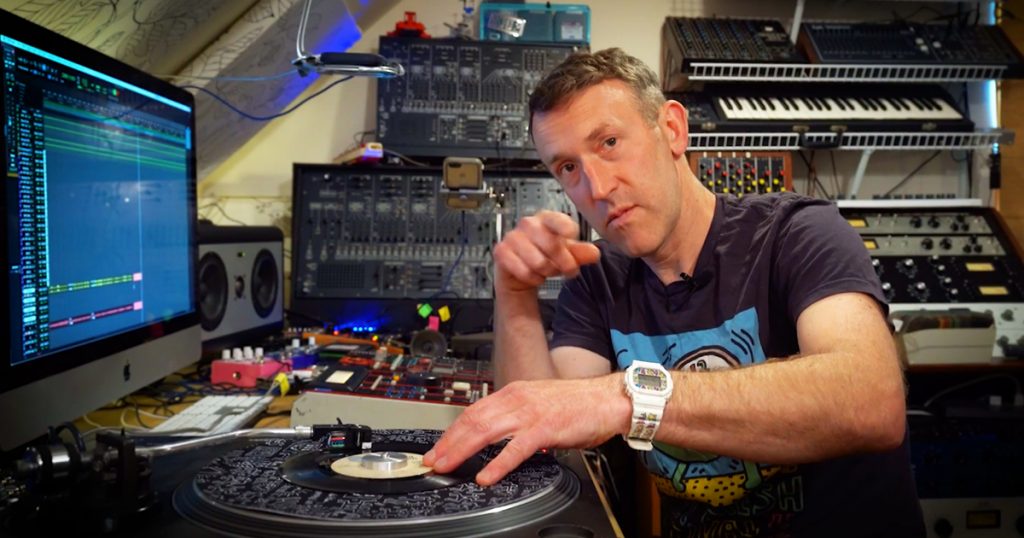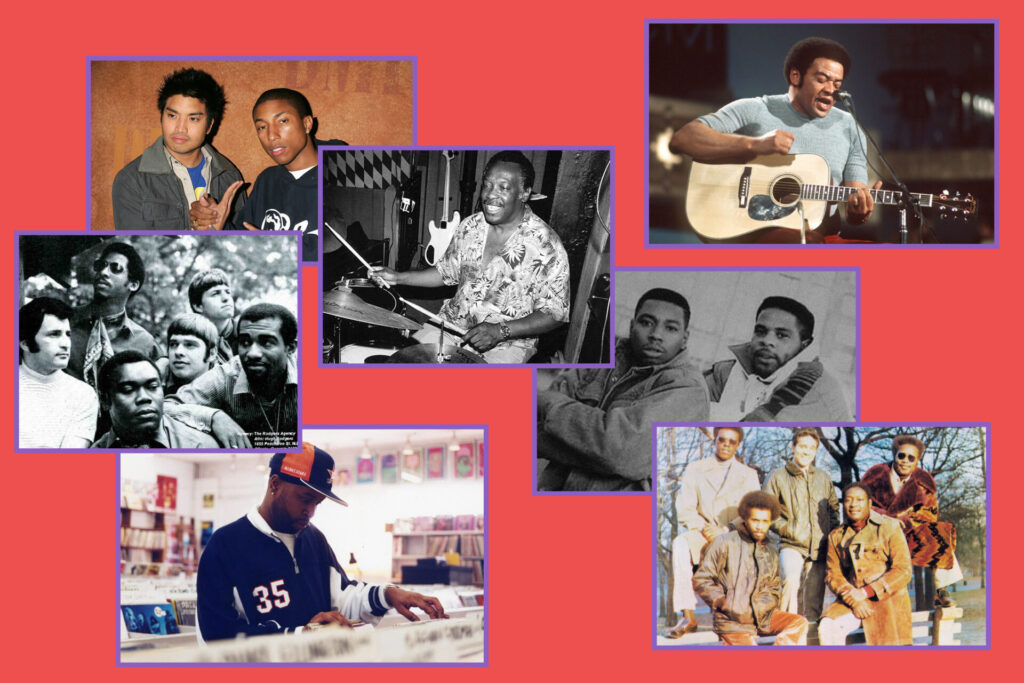+ Create and arrange original, instrumental hip-hop music from sampling pioneer RJD2 in his Soundfly course, RJD2: From Samples to Songs.
When you think of hip-hop, your first thought might be to think of rappers. Emcees are the voice of the genre and their larger than life personas combined with their clever wordplay has carried rap music to new heights and global success.
However, when we examine the origins of hip-hop and how it has evolved over the last 50 years, what becomes apparent is that the music is mostly propelled by innovations in rhythm. In the early 1970s, DJ Kool Herc became well known for throwing parties in which he would continuously loop small sections of records known as breakdowns or breaks. These breaks mostly featured unaccompanied drums and percussion playing a groove for five to ten seconds.
Early hip-hop music was defined by finding the funkiest drum breaks from funk and disco records and looping them in order to create a hypnotic trance of rhythm.
As technology continued to evolve in the late 1970s and early ’80s, drum machines and samplers allowed DJs and producers to create new rhythms from existing breaks as well as program their own drum patterns on machines such as the Roland TR808.
By the late 1980s, the rhythmic identity of hip-hop was cemented as a combination of electronic drum machines and funky drum breaks which were manipulated to create the perfect backdrop for innovative emcees.
Let’s explore some of the most popular rhythms in hip-hop to see how they’ve affected the culture and pushed the music forward. And if you’re a drummer or beat maker looking to learn more about modern rhythmic patterns, definitely check out The Pocket Queen’s course on Soundfly, Moving at Your Own Tempo.
The Honey Drippers – “Impeach The President”
“Impeach the President” is a song by an obscure 70s funk band known as The Honey Drippers which was really just a band of high school students assembled by producer Roy C. Hammond. The song’s intro contains an iconic drum break that has been sampled over 800 times (if not more!).
Some notable songs that used this break are: “Unbelievable” by Notorious B.I.G., “Rebirth of Slick” by Digable Planets, “I Can” by Nas, “That’s the Way Love Goes” by Janet Jackson, and “Jump” by Kriss Kross.
What makes this break so infectious?
There’s something about the heavily syncopated kick drum pattern and open hi-hat on the second eighth note of beat 3 that makes this beat stand out. This groove has been sampled and interpolated so many times that it has become a staple sound of hip-hop and is instantly recognizable as a signature sound within hip-hop’s rhythmic lexicon.
Producer Marley Marl is the first producer to use the break in an actual recording, “The Bridge” by MC Shan.
Yet Marl revealed that this break — like many of the early drum breaks in hip-hop — was already being played at parties and park jams by legendary DJs such as Kool Herc and Afrika Bambaataa.
James Brown – “Funky Drummer”
Some hip-hop aficionados may argue that James Brown’s “Funky Drummer” is the greatest drum break of all time. This is a claim that’s hard to debate as this drum break has been used at least 1,775 times according to the popular music website Who Sampled. Clyde Stubblefield was the drumming genius behind this powerful break.
Some notable usages of the break are “Fight the Power” by Public Enemy, “Mama Said Knock You Out” by LL Cool J, the “Run’s House” by Run-D.M.C.
When originally released James Brown’s tune was not a commercial success. However, the drum break that appears towards the end of the song became a go to loop for early hip-hop DJs; and as industrious as James Brown was, when he became aware of this, he re-released the song in 1986 on a compilation album along with a three-minute version of the drum break looped over and over.
+ Read more on Flypaper: “Sonic Swagger: The Best Samples Left Naked in Hip-Hop.”
Needless to say, the break instantly grew in popularity amongst hip-hop producers and became one of the most recognizable rhythms in history.
The Showboys – “Drag Rap”
“Drag Rap” was an obscure single by New York City rap group The Showboys. This song along with Cameron Paul’s “Brown Beats” became the rhythmic blueprint for a new wave in Southern hip-hop known as bounce music.
DJ Jimi is credited with being one of the first DJs to put these rhythms together in the popular song “Where They At.”
Producers and DJs such as Mannie Fresh, DJ Black n Mild, Beats by the Pound (aka The Medicine Men), and many more took these sounds which have been dubbed the “Triggerman Beat” a created the musical pulse of New Orleans hip-hop in the 1990s.
Bounce music would see a revival in the late 2010s with artists such as Big Freedia, Drake, and Beyoncé incorporating the classic Triggerman Beat in their music.
+ Learn more on Soundfly: Create and arrange original, sample-based music with sampling pioneer RJD2’s online course From Samples to Songs.

The Winstons – “Amen Brother”
The “Amen Break” is one of the most sampled pieces of recorded music. This drum break comes from The Winstons’ song “Amen Brother” which was released in 1969 and performed by drummer Gregory Coleman. This break was a favorite of early hip-hop producers and DJs; by the early 90s the break had already been sampled hundreds of times.
According to Who Sampled, “Amen Brother” has been sampled 6,022 times.
This one break became the backbone for UK dance music sub-genres like drum ‘n bass and jungle music. The four bar loop features the same beat as the main tune for two bars and then a slight variation on bars 3 and 4 which create a satisfying rhythmic conversation when looped continuously.
Producers from many genres of music have dissected these four bars to create entire styles of rhythmic cadences based on sampling and rearranging the loop in various configurations.
Bill Withers – “Use Me”
“Use Me” is a popular song by Bill Withers that features funky acoustic guitar riffs and hard smacking drums. The song peaked at #2 on the Billboard charts when it was released in 1972 and was Withers’ second biggest hit. One of the stand out features of this song is the beautifully syncopated drum groove performed by James Gadson.
At numerous points in the song, the rest of the instruments drop out leaving only the vocals and drums remaining. The track has a two-second drum break at the end of the first verse that has been sampled by countless hip-hop producers.
You can hear James Gadson’s groove in Kendrick Lamar’s “Sing About Me, I’m Dying of Thirst” as well as in Nas’ classic Kanye-assisted cut “Still Dreaming.”
+ Read more on Flypaper: “’Synthetic Substitution’: How RJD2 Samples Soul Records.”
The “Grindin’” Sound
In the early 2000s, it was safe to say that Pharrell Williams and Chad Hugo, known as the production duo The Neptunes, had a solid stamp on popular music. You couldn’t escape their sound on the radio, whether it was in tracks for Jay-Z, Justin Timberlake, or Madonna.
In 2001, The Neptunes founded their own label, Star Trak Entertainment, and debuted the music of the duo, Clipse from Virginia Beach, which included the street anthem single, “Grindin.”
This track introduced the Clipse to mainstream hip-hop audiences while also introducing more minimalist and sparse production, a style that would become the center piece of some of The Neptunes work. What makes this groove so magnetic is its simplicity and sound choices. The drum pattern itself is not overly complicated, but it sounds like it was made with trash cans, desks, slamming doors and things you would find in a junkyard.
This combination of elements instantly inspired a generation of kids to recreate this beat on school desks and lunch tables around the country. It was a reminder to the hip-hop mainstream that, at its core, a great rap song can exist over a well-crafted drum beat or break and nothing else.
The “Dilla Swing”
Hip-hop evolved from funk, disco, jazz, and soul, and developed during the rise of house and techno music. It is a musical genre that is defined somewhat by its close musical relationship with machines. That said, DJs and producers have always found creative ways to bend their machines into a more “human” sound.
And none more creative than J Dilla. Dilla and his talents with various models of the Akai MPC sampler changed the way entire generations of musicians heard music and heard groove. Dilla’s style of microchopping obscure samples to create new compositions was more akin to jazz than hip-hop in its construction.
And his style came to be known as the “Dilla Swing” (also, “Dilla Time” and “Drunken Swing”).
Drum programming in rap beats was mostly defined by looping drum breaks or perfectly quantized patterns on drum machines. Dilla’s approach incorporated performing the track beat-by-beat often by hand into the sampler. Therefore he would push certain instruments in his drum patterns ahead or behind the beat to create a more open pocket feel.
And Dilla was inspired to use less conventional loop patterns. For example, instead of a simple four-bar loop repeating, he might have elements that change from measure to measure, or phrases that only repeat every 20 bars or so. Listen to the kick drum on The Pharcyde’s “Runnin’.”
Dilla’s style has influenced an entire generation of producers and is quite notably the backbone of the lo-fi hip-hop movement as well as the “Beat Music” scene in Los Angeles, which has produced artists like Flying Lotus, Kiefer, Teebs, Dibia$e, Samiyam, and Ras G.
And his off kilter rhythms inspired drummer Questlove to switch his approach to hip-hop drumming which resulted in him heavily emulating Dilla’s style on D’Angelo’s pivotal record, Voodoo.
If you want to dive into more hip-hop rhythms and learn how to create your own beats check out my course, The Art of Hip-Hop Production. Or check out the variety of other courses Soundfly has to offer here.
Keep on Grooving…
Continue your learning with hundreds of lessons on songwriting, mixing, recording and production, composing, beat making, and more on Soundfly, with artist-led courses by Kimbra, Com Truise, Jlin, Kiefer, RJD2, and our new The Pocket Queen: Moving at Your Own Tempo.




